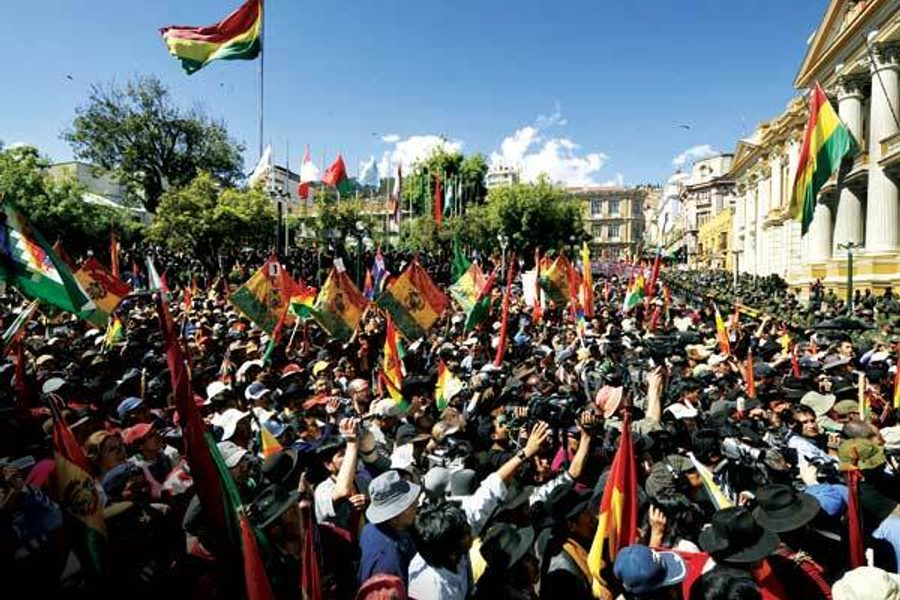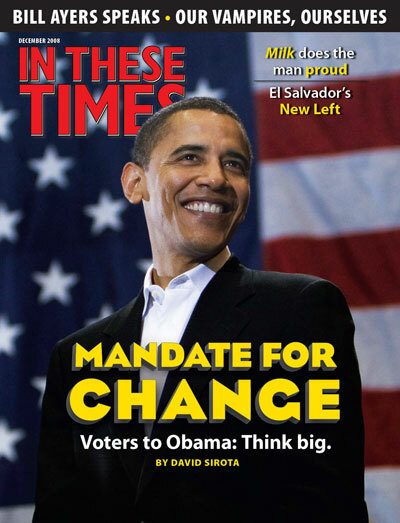Morales Remakes Bolivia
A new constitution grants indigenous people unprecedented rights
Alex Van Schaick

LA PAZ, Bolivia – On Oct. 21, Bolivian President Evo Morales approved a law convoking a national vote on a new constitution in front of thousands of supporters in the capital La Paz. Seconds later, Morales seemed close to tears as he addressed the crowd and celebrated the passage of the document designed to empower Bolivia’s indigenous majority.
The proposed constitution, which analysts expect to be ratified by a wide margin on Jan. 25, 2009, will be one of Morales’ most important achievements since he became president in 2005. After 10 months of political wrangling – that culminated in 18 hours of nonstop congressional negotiations – the four major parties in Bolivia’s Congress finally agreed on the proposed constitution that morning.
Vice President Alvaro Garcia Linera, who was present as Morales signed the bill into law in the Plaza Murillo in front of Bolivia’s Congress, emphasized the historical nature of Bolivia’s new magna carta.
“This constitution, for the first time in Bolivia’s history, was constructed from below, from the unions, the trade guilds, the rural communities and the universities,” Linera told the crowd.
Eugenio Rojas, mayor of Achacachi, an ethnically Aymara Indian highland town located two hours outside of La Paz on the banks of Lake Titicaca, believes that the draft charter will end centuries of oppression against Bolivia’s indigenous peoples Clad in a red poncho and chicote whip – symbolizing his status as a community authority – Rojas explains that “for us, the indigenous, the new constitution signifies a re-foundation of the country and a major landmark in the history of Bolivia.”
A march, then a celebration
A week before the bill’s passage, the National Coordinator for the Change, an umbrella organization of pro-government popular organizations, began five different marches around Bolivia, all heading toward La Paz. The aim: to pressure Congress to put the new constitution to a vote.
Before dawn on Oct. 20, the marches converged in El Alto – the large, Aymara satellite city on the rim of the La Paz valley, 13,000 feet above sea level. As members of Bolivia’s Congress worked that morning to reach an accord, Morales personally led tens of thousands of indigenous people, small farmers and workers from El Alto down into the main avenue of La Paz. Local residents and other onlookers cheered as traditionally dressed indigenous groups entered the city.
By midday, Morales had led the group through police cordons into the Plaza Murillo. They occupied the plaza for 24 hours until Linera emerged from Congress to hand-deliver to Morales the law summoning the constitutional referendum.
The crowd erupted in jubilation. Miners waved their helmets and many participants broke into tears.
In the last decade, Bolivia’s social and populist movements have won significant power over their government. The road to the recent constitutional referendum is but one example.
In the early 2000s, Bolivia underwent a period of upheaval known in local political discourse as “the process of change.” Many social movements emerged to help roll back 20 years of neoliberal policies that privatized public resources and instituted other pro-market principles that most Bolivians found disastrous.
This popular resistance forced two presidents to resign, discredited Bolivia’s traditional political parties, and created the conditions for Morales – with his Movement Toward Socialism (MAS) party – to become the country’s first indigenous president.
But the changes faced opposition from civic organizations and departmental prefects (governors) from Bolivia’s whiter and wealthier lowland departments of Beni, Pando and Santa Cruz. They support departmental autonomy, which demands that many of the central government’s powers be turned over to departmental governments. And while departmental autonomy would help end the country’s overly centralized bureaucracy and lead to regional development in the lowlands, it would also allow elites to effectively opt-out of Morales’ plans to redistribute land and wealth.
The indigenous constitution
MAS Congressman Jorge Silva explains that, the new constitution represents “a conquest for Bolivia’s indigenous people who, since colonial times, have felt enslaved, marginalized, excluded and have been the object of a virulent racism that has only multiplied in recent years.”
The new constitution strongly reflects the pro-indigenous current in the Morales government. For example, it labels the Bolivian state “pluri-national” – out of respect for Bolivia’s pre-Columbian indigenous nations and the Afro-Bolivian population – and it recognizes each of the country’s 36 indigenous languages as “official languages” of the state. After ratification, national and departmental governments will be required to use at least one indigenous language alongside Spanish to ensure that all people will be able to communicate accurately with the state during a trial or bureaucratic process.
The main success for Bolivia’s native peoples is indigenous autonomy. For the them, autonomy means the right to self-determination and self-government in their ancestral territories. These principles are stipulated in the 2007 U.N. Declaration on the Rights of Indigenous Peoples, to which Bolivia is the first signatory.
Article Four of the declaration states, “Indigenous peoples, in exercising their right to self-determination, have the right to autonomy or self-government in matters relating to their internal and local affairs, as well as ways and means for financing their autonomous functions.”
The proposed constitution effectively cements this right in Bolivia’s legal system. Specifically, it gives indigenous people the right to form their own autonomous indigenous areas, although such areas would still be subject to some state oversight. Within these autonomous zones, indigenous people will be able to draw up their governing statutes, elect their authorities according to their customary practices, define plans for their economic development, and manage their renewable resources, among other rights.
Another key gain is the inclusion of indigenous community justice into the judicial system, which Bolivians widely perceive as being incapable of guaranteeing justice to the majority of citizens, particularly those in rural areas. Bolivia’s indigenous communities argue that they can administer justice themselves, according to traditional communal practices.
Anthropologist Daniel Goldstein, director of the Center for Latin American Studies at Rutgers University, explains that community justice – as practiced in Andean communities – stresses “reconciliation over punishment” and seeks to “re-educate the offender who violates the rules or norms of the community, so that he or she can be reincorporated as a community member.”
The new constitution incorporates indigenous justice as a special jurisdiction that will apply only within indigenous communities, not outsiders, and it must not contradict the rights established in the constitution.
How the deal got done
The impending arrival of the marchers in La Paz increased tensions in Congress.MAS negotiators finally broke through with moderates in the main opposition party, Social and Democratic Power, or PODEMOS.
In order to get PODEMOS on board, MAS made several key concessions. One was to allow Morales to seek only one more five-year term, instead of the two terms the original proposed constitution would have permitted. In a gesture to placate the lowlands’ departmental autonomy movement, MAS also agreed to hand over more power to departmental governments.
The initial draft also made substantial changes to the legislative branch, such as eliminating the Senate in favor of a unicameral system, changes that would have favored MAS in the upcoming elections. Opposition lawmakers rolled back most of those proposals, keeping the overall structure of the legislature intact.
Despite the modifications, the fact that MAS reached a consensus with a majority of the congressional opposition – without gutting the constitution – represents a major victory for the party.
Constitutional conflict
For most of the year, the possibility of a deal on the constitution seemed bleak. Jorge Quiroga, the head of PODEMOS, stated repeatedly that his party’s first priority was to stop the new constitution from going to vote. By early October, negotiations between MAS and the opposition had broken down on seven occasions.
But two events dramatically changed the scenario. On Aug. 10, Morales won an approval rating of 67 percent in a recall referendum called for by both MAS and PODEMOS, a substantial increase over the 53 percent he received in the 2005 elections. The victory reaffirmed his mandate and revealed the regional isolation of the opposition’s political support.
The second event was the departmental autonomy movement waging violent protests against the government.
On Aug. 28, Morales issued an executive decree mandating a referendum on the draft constitution, bypassing congressional approval, and giving his opposition grounds to cry foul. In the lowlands, the opposition called for civil disobedience to protest the move.
Bolivia’s National Electoral Court struck down Morales’ decree, reaffirming that only Congress has the power to convoke a referendum. Morales agreed to respect the decision, but events soon spiraled out of control. In the lowlands, more radical opposition members used the incident to launch a wave of violence to destabilize the national government.
During the first two weeks of September, right-wing political and civic leaders of the departmental autonomy movement turned up their rhetoric. According to Bolivia’s state news agency and other press reports, Jorge Melgar Quete, a TV-show host and civic leader in the lowland city of Riberalta, told viewers, “We have to liquidate President Morales.” He also called highland indigenous people a “damned race, poorer than rats because of their laziness” and gave any highland migrants “24 hours to leave Riberalta.”
Next, youth groups affiliated with the departmental autonomy movement looted dozens of public facilities, including several airports and the national telecom company’s building in Santa Cruz. They destroyed the offices of several indigenous organizations and pro-indigenous NGOs.
The national government took no police action until mid-September, when an armed group of departmental autonomy supporters – allegedly acting under orders from Leopoldo Fernandez, then-prefect of the lowland department of Pando – opened fire on MAS supporters traveling with their families to a union rally. Sixteen indigenous farmers and two autonomy supporters were killed.
Following the incident, the Morales government declared a state of siege in Pando, arrested Fernandez on murder and terrorism charges, and appointed an admiral to serve as Pando’s interim prefect.
The right wing’s use of violence caused a political reversal of fortune for the constitution. According to PODEMOS Sen. Carlos Böhrt, the lowland attacks and the specter of civil war were the determining factors in the negotiations’ success.
“The violence and threat to national unity not only strengthened the group of [those interested in dialogue], but also gave pause to radicals on both sides, creating the subjective and objective conditions that made an agreement possible,” Böhrt says.
Political hegemony at last?
Given the weakness of the Bolivian state and its lack of a functioning judicial system, many of the rights enshrined in the constitution may take years to enforce. Political leaders have said that the new legal and administrative system will take between five to 10 years to implement fully.
However, in terms of power, both MAS and PODEMOS members agree that the pact indicates MAS’ strength.
“The political scenario is marked by MAS’ almost hegemonic position and dispersed opposition,” says PODEMOS’ Böhrt. “PODEMOS, which was the strongest party in the opposition, is debilitated – we are debilitated. We ourselves doubt the future of PODEMOS.”
Indeed, MAS’ power might increase over the years, given the party’s support among key popular sectors and its successful campaign apparatus. If the constitution is approved, it will be followed by presidential and congressional elections in December 2009 and local elections in April 2010. MAS could take a sizable majority in Congress and claim power in several municipalities currently controlled by the opposition.
Most important, according to MAS’ Silva, the opposition lacks a coherent, positive vision for the country to mobilize support. Instead, he says, it has offered only criticism of the government’s agenda.
Asked what the opposition can do to contest MAS’ growing political dominance, Silva simply responds, “Nothing,” and breaks into a broad smile.





